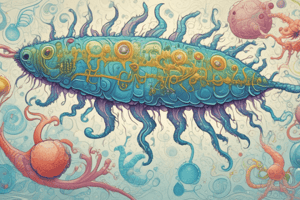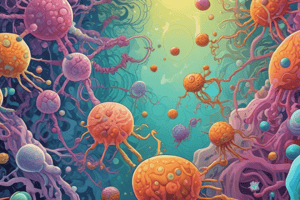Podcast
Questions and Answers
Which of the following is NOT a characteristic of endospores?
Which of the following is NOT a characteristic of endospores?
- Being formed inside a parent cell
- Remaining dormant for years
- Being formed by bacteria like Streptococcus (correct)
- Requiring water to germinate
What is the function of the capsule in bacteria?
What is the function of the capsule in bacteria?
- To increase the movement of waste out of the cell
- To protect the cell from desiccation (correct)
- To increase the movement of nutrients into the cell
- To increase the cell's viscosity
Which of the following is NOT a part of the cell envelope?
Which of the following is NOT a part of the cell envelope?
- Cytoplasm (correct)
- Outer membrane
- Periplasmic space
- Cell wall
What is the function of autolytic enzymes in spore germination?
What is the function of autolytic enzymes in spore germination?
Which of the following bacteria is known for forming terminal spores?
Which of the following bacteria is known for forming terminal spores?
What type of organisms are bacteria?
What type of organisms are bacteria?
What is the purpose of negative staining using India ink?
What is the purpose of negative staining using India ink?
What is the main difference between bacterial and animal cells?
What is the main difference between bacterial and animal cells?
What is the difference between a capsule and a slime layer?
What is the difference between a capsule and a slime layer?
What is the function of plasmids in a bacterial cell?
What is the function of plasmids in a bacterial cell?
What is the composition of bacterial cell walls?
What is the composition of bacterial cell walls?
What is the effect of the capsule on the appearance of bacterial colonies?
What is the effect of the capsule on the appearance of bacterial colonies?
What is the shape of bacterial DNA?
What is the shape of bacterial DNA?
What is the function of ribosomes in a bacterial cell?
What is the function of ribosomes in a bacterial cell?
What is the process by which bacteria divide?
What is the process by which bacteria divide?
What is the term for the region in a bacterial cell where the DNA is found?
What is the term for the region in a bacterial cell where the DNA is found?
What is the primary purpose of autoclaving in bacterial cultures?
What is the primary purpose of autoclaving in bacterial cultures?
What is the approximate percentage of dry weight of the cell that the cytoplasmic membrane makes up?
What is the approximate percentage of dry weight of the cell that the cytoplasmic membrane makes up?
What is the purpose of septal mesosomes?
What is the purpose of septal mesosomes?
What is the function of the cytoplasmic membrane in terms of electron transport?
What is the function of the cytoplasmic membrane in terms of electron transport?
What is the shape of bacteria known as Bacilli?
What is the shape of bacteria known as Bacilli?
What is the term for the process of binary fission in bacteria?
What is the term for the process of binary fission in bacteria?
What is the size range of bacteria of medical importance?
What is the size range of bacteria of medical importance?
What is the purpose of mesosomes in bacterial cells?
What is the purpose of mesosomes in bacterial cells?
What is the characteristic of bacterial chromosomes?
What is the characteristic of bacterial chromosomes?
What is the purpose of Gram stain?
What is the purpose of Gram stain?
What is the characteristic of Gram positive bacteria?
What is the characteristic of Gram positive bacteria?
What is the characteristic of intra-cytoplasmic inclusions?
What is the characteristic of intra-cytoplasmic inclusions?
How do Gram negative bacteria differ from Gram positive bacteria?
How do Gram negative bacteria differ from Gram positive bacteria?
Who developed the Gram stain technique?
Who developed the Gram stain technique?
Which of the following Gram-negative bacteria is a potential pathogen in the oropharynx?
Which of the following Gram-negative bacteria is a potential pathogen in the oropharynx?
Which of the following bacteria is known for causing infection in immunocompromised patients?
Which of the following bacteria is known for causing infection in immunocompromised patients?
Which of the following Gram-negative rods are oxidase positive?
Which of the following Gram-negative rods are oxidase positive?
What is the mechanism of action of C. botulinum's toxin?
What is the mechanism of action of C. botulinum's toxin?
Which of the following bacteria is an anaerobe that resists penicillin?
Which of the following bacteria is an anaerobe that resists penicillin?
Which of the following is a sequelae of C. tetani?
Which of the following is a sequelae of C. tetani?
Which of the following Gram-negative bacteria is a fastidious GNR?
Which of the following Gram-negative bacteria is a fastidious GNR?
Which of the following is NOT a characteristic of C. tetani?
Which of the following is NOT a characteristic of C. tetani?
Study Notes
Bacteria Classification
- Bacteria are unicellular, microscopic, free-living microorganisms that can perform essential life functions.
- They have both DNA and RNA, lack chlorophyll, and can be found in various environments, including water, food, soil, and air.
- Bacteria can survive in extreme conditions, such as pH, oxygen, temperature, and atmospheric temperature.
Morphology of Bacteria
- Bacteria have a prokaryotic cell structure, meaning they lack a nucleus and organelles bound in membranes.
- They have a single circular chromosome, no histones associated with DNA, and a cell wall made of peptidoglycan.
- They have smaller ribosomes and divide by binary fission.
Bacterial Cell Structure
- The nucleus is also called the nucleoid, nuclear body, or nuclear region.
- DNA is a single circular chromosome that is coiled up and floats in the cytoplasm.
- The cytoplasm is a watery, soft gel that contains organic and inorganic solutes, vitamins, coenzymes, ribosomes, and a network of fine fibrils.
- Plasmids are small, circular, double-stranded DNA molecules that can replicate independently.
Gram Staining Technique
- Gram staining was developed by Hans Christian Gram in 1884.
- It differentiates Gram-positive bacteria, which remain colored after staining, from Gram-negative bacteria, which do not retain the dye.
- Gram-positive bacteria are more susceptible to antibiotics due to the lack of an outer membrane.
- Gram-negative bacteria contain an outer membrane, making them less susceptible to antibiotics.
Gram-Positive Bacteria
- Examples of Gram-positive bacteria include Bacillus, Clostridia, and Actinomycetes.
Gram-Negative Bacteria
- Examples of Gram-negative bacteria include Neisseria gonorrhoeae, Neisseria meningitidis, Enteric bacteria, Pseudomonas, and Bacteroides fragilis.
- Gram-negative bacteria can be further divided into fastidious GNRs, anaerobic GNRs, and oxidase-positive or -negative GNRs.
Bacterial Cell Envelope
- The cell envelope refers to all the layers from the cell membrane outward, including the cell wall, periplasmic space, outer membrane, and capsule.
- All free-living bacteria have a cell wall, and the periplasmic space and outer membrane are found in Gram-negative bacteria.
Binary Fission
- Binary fission is a process of cell division where a single DNA molecule replicates, attaches to different parts of the cell membrane, and then divides into two identical cells.
Shapes of Bacteria
- Bacteria can have various shapes, including cocci (spherical or oval), bacilli (rod-shaped), vibros (comma-shaped), spirilla (rigid spiral forms), and spirochetes (flexible spiral forms).
Spore Germination
- Spore germination is the process by which a dormant spore becomes active and forms a vegetative cell.
- Bacteria with spores include Bacillus and Clostridia.
Capsule
- The capsule is a layer of extracellular polymeric substances surrounding the bacterial cell.
- It can protect the cell from desiccation, anti-bacterial agents, and phages, and maintain cell viscosity.
- The capsule can be stained using negative staining with India ink.
Intra-Cytoplasmic Inclusions
- Intra-cytoplasmic inclusions are rough granules that can be made up of glycogen or starch.
- They can be stained with polychrome methylene blue or toluidine blue.
Studying That Suits You
Use AI to generate personalized quizzes and flashcards to suit your learning preferences.
Description
Learn about the characteristics and morphology of bacteria, including their cell structure and ability to survive in extreme conditions.




